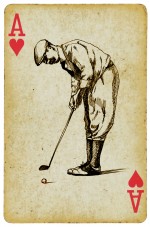When do you stop golfing? The day before your funeral. My stepfather had a hole in one at age 94. I golfed six weeks after open heart surgery following my 75th birthday, and still shot an 82. I’m a member of the Canadian Seniors Golf Association, which has 140 emeritus members over age 80. It is a marvellous game that’s been a joy and influence in my life.
My mother Ada introduced me to golf. She was a Hutchison whose family hailed from Aberdeen, Scotland. In her teens my grandparents sent her across the ocean to boarding school at St. Andrew’s. Mother was a great lady with a nice little Scottish swing she picked up as a schoolgirl on the Old Course. She passed away this past January at 97. It seems that golfers have good genes!
I still travel to Scotland to golf at Muirfield, Prestwick and St. Andrew’s. They have a civilized, social approach to golf there, where they frequently play foursomes. It is first and foremost a game. My late father Mel, who also derived great pleasure from the game, always stressed the importance of being good-humoured in defeat, and gracious in victory.
I was introduced to golf as a 9-year old at the Laurentian Golf Club in Ste. Agathe-des-Monts, Quebec. My first summer job was doing menial tasks in the Laurentian GC pro shop at age 10. I grew to love the work, the people and the game. At age 12, I was the youngest junior at the Royal Montreal Golf Club, the oldest in North America; I was a member there for fifty years and a director in their Centenary year, 1973.
Some people have a natural ability to pick up a guitar and strike a chord – a talent I wish I had. Golf requires some natural balance, rhythm and co-ordination, though it is wrong to say you must start very young. PGA champion Larry Nelson did not take up the game till he was 21, and the great Greg Norman only started at 15.
Competitive sports are a great preparation for life’s many challenges. Schools today that have no competitive sports programs are missing out. I played varsity golf and hockey at Princeton University, and learned endurance, patience and sportsmanship.
Over the years much serious business has been conducted on golf courses. An average round is four hours, often followed by lunch or dinner. In my days as an attorney seeking business in the U.K. for my maritime law and insurance practice, golf was a major part of my business promotion activities. There is a warm, human element to the game. Forty years later, many of my U.K. clients remain good friends.
Golf in the beginning was one of the more elitist games, played mainly at private clubs. It was difficult to obtain access to instruction and facilities, and the equipment was expensive. It has become much more populist now, largely due to the influence of people like Tiger Woods. There are public links all over the world, available in large part to anyone. The game has become democratized and accessible.
I’ve had the privilege of being invited to join many clubs in Canada and abroad – St. Andrew’s, Muirfield and Prestwick in Scotland; Royal St. George’s and Walton Heath in England; Royal County Down and Royal Portrush in Northern Ireland; Redstick in Florida. These are very special clubs which emphasize the history and tradition of the game. At Muirfield and Redstick caddies are available, and one generally plays there without an electric cart. That’s rare nowadays.
As a boy, my handicap ranged from 3 to 9; it’s now about 15 and hopefully not climbing too fast. My wife once declared, “You’re addicted, you know.” Yet golf has brought me such pleasure from boyhood through my 67 years on the links!
(Editor’s note: the author, a former Conservative chair of the Senate banking and energy committees, served 19 years in the Upper House and retired in 2012)









